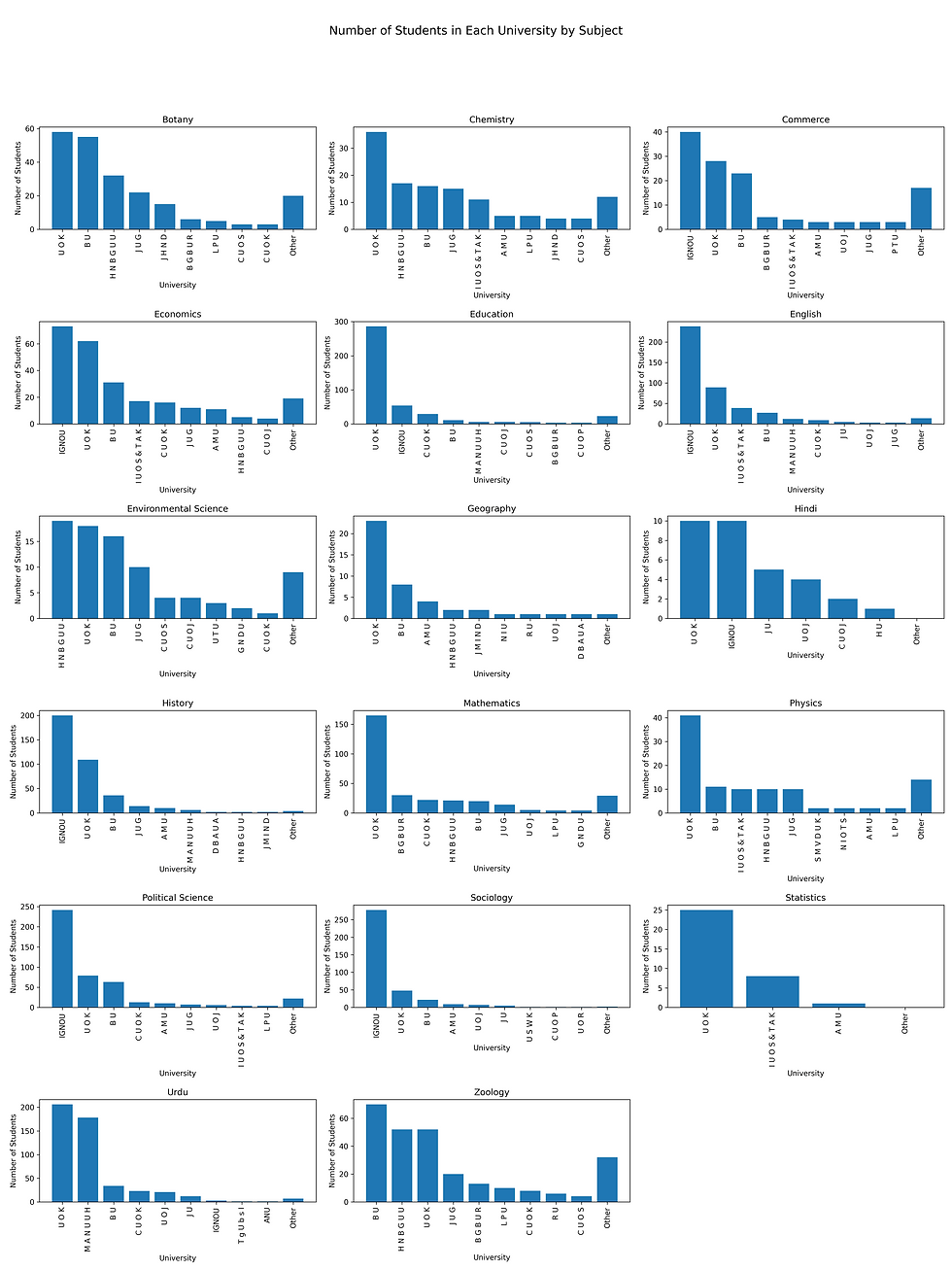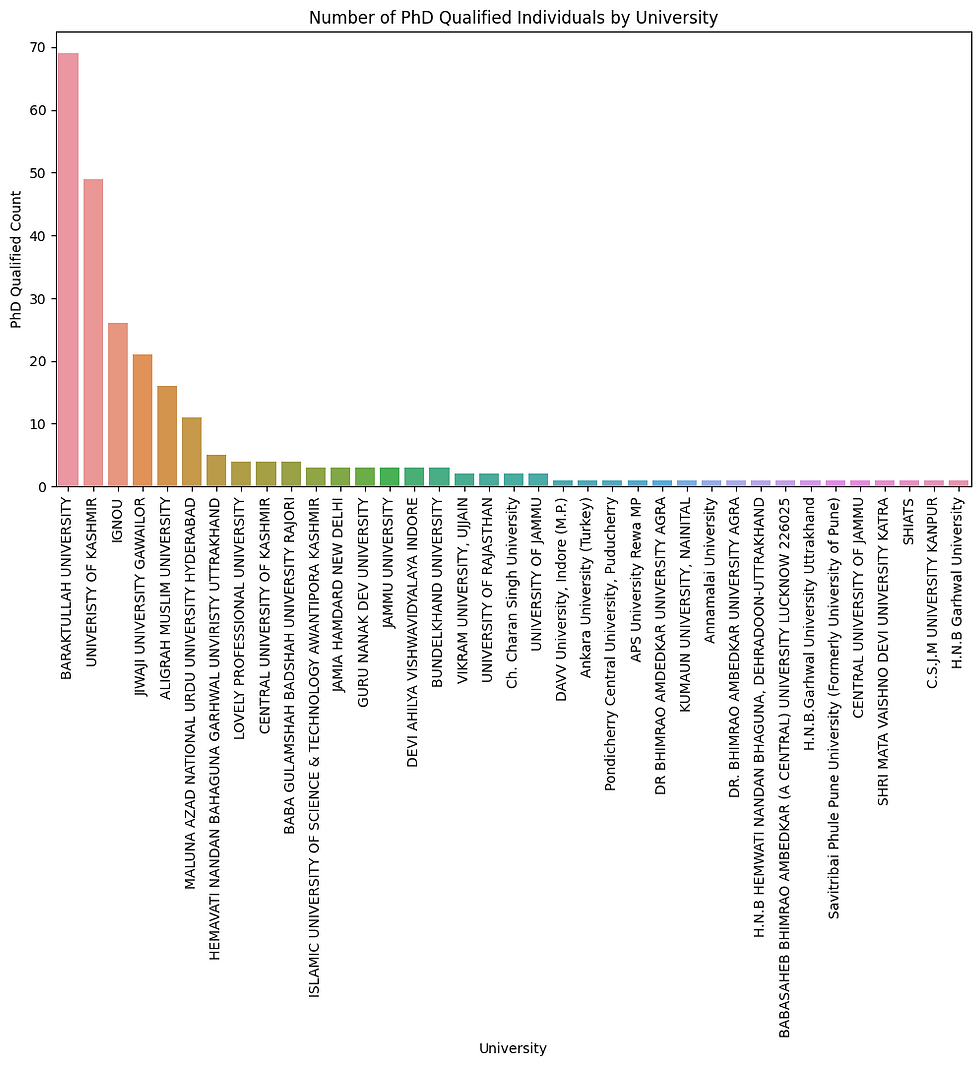Unveiling Insights: Data Analysis of Anantnag District's Teaching Support Recruitment Merit List
- MOHSIN FAURKH
- Sep 10, 2023
- 3 min read
In an era driven by data, it's imperative to explore the hidden narratives behind numbers and statistics. Recently, the Directorate of School Education Kashmir released the General Merit List for the recruitment of Cluster Resource Coordinators for Teaching Support in the Kashmir Division. As a data science enthusiast, I eagerly dived into the dataset for Anantnag District, aiming to uncover some fascinating insights. In this article, I'm thrilled to share my discoveries, shedding light on various aspects of the candidates' backgrounds, universities, qualifications, and more.
University Distribution: A Pie Chart Perspective


To kick off the analysis, I examined the distribution of candidates across different universities. Notably, 32% of the candidates hailed from Kashmir University, making it the leading contributor to the merit list. The second-largest group, at 27.4%, belonged to IGNOU, followed by 10.2% from Barkatullah University. This distribution unveils the diversity of educational backgrounds within the Anantnag District.
Subjects and Universities: A Tale of Choices

Digging deeper, I explored the number of students in each university, subject-wise. Intriguingly, Commerce, Economics, History, and Political Science students predominantly originated from IGNOU. The top three universities driving the recruitment included Kashmir University, IGNOU, and Barkatullah University, further highlighting the diversity in educational institutions.

NET/SET Qualified Candidates: Leading the Way
One of the most significant revelations in my analysis was the substantial difference in NET/SET qualifications among universities. Kashmir University stood out with an impressive 175 candidates holding NET/SET qualifications, while other universities lagged behind with fewer than 20 qualified candidates each. This observation underscores the importance of academic achievements in this competitive landscape.

Subject-wise NET/SET Qualifications: Unveiling Trends

When we delved into NET/SET qualifications by subject, Urdu emerged as the frontrunner, followed closely by Education, History, and Political Science. These findings shed light on the subjects with a higher prevalence of qualified candidates, providing valuable insights into the educational landscape.
PhD Qualifications: A Subject-wise Breakdown

Turning our attention to doctoral qualifications, we noticed that Political Science boasted the highest percentage of candidates holding PhDs, with 16.7% of applicants in this subject having achieved this advanced degree. Urdu, History, and Botany also exhibited significant numbers of PhD-qualified candidates.

Percentage of Marks: Unveiling the Spread

A visual representation of the percentage of marks across subjects through box plots revealed variations in academic performance. This analysis helps us understand the diversity in candidates' academic achievements within different subjects. For example, in botany, all students who applied for the post have a percentage of marks between 70% and 80%.
Age Distribution: From Youth to Experience
Intriguingly, the age distribution of candidates ranged from 21 years to 40 years, showcasing the diversity in age groups seeking opportunities in the teaching support role. This wide age range suggests that this recruitment process attracted candidates from various stages of their careers.

Age Distribution by Subject: Where Experience Matters
Further breaking down the age distribution by subject, we observed varying patterns that suggest certain subjects might appeal to candidates at different stages in their lives. This insight provides a nuanced understanding of career choices within the district.


Conclusion
So to conclude, this data analysis journey into the General Merit List for hiring Cluster Resource Coordinators in Anantnag District has uncovered a wealth of insights. The data not only provides a snapshot of the candidates but also paints a broader picture of the educational landscape in the region.
It's important to note that a higher number of candidates in any subject or university does not necessarily equate to a higher unemployment rate. It could reflect the popularity of a subject or institution among aspirants. Nevertheless, these findings offer valuable information for policymakers, educators, and aspiring candidates alike.
As we continue to embrace data-driven decision-making, let's harness the power of data to inform and shape our educational and employment opportunities. The future, after all, belongs to those who understand the stories hidden within the numbers. For more details, you can find the data along with the code here https://colab.research.google.com/drive/1X8D-xhzblirRtkZDMF0NhSpod9llSKS7?usp=sharing
Disclaimer: This analysis is based on the available data from the Directorate of School Education Kashmir as of 10-09-2023. The interpretations and conclusions drawn are solely from the author's perspective.






Comments